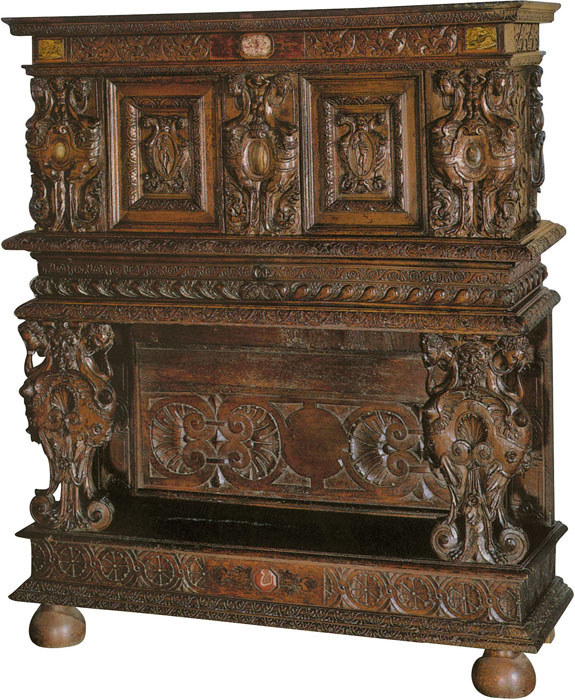“Harpys” sideboard, c. 1560-1570.
Carved wood, 147 cm. Castle of Écouen,
Musée national de la Renaissance.
Carved wooden furniture
What we said previously about the uses of primitive furniture renders it needless to insist on the fact that the greater part of it was made of oak. Nothing less than this solid material assembled by robust carpenters could serve for resisting the endless jolting of constant journeys. Understandably, it is unnecessary to dwell long on the subject of the first chests, the majority of which must have disappeared. It is when art begins to manifest itself that interest commences. We have already mentioned the iron-bound coffer of the Musée Carnavalet of Paris. We will also examine, as a characteristic of the end of the 13th century, the curious piece purchased by the Musée de Cluny. It is a bahut of which the sides are ornamented with arches framing figures of men-at-arms in full armour and jugglers. One end exhibits a riding warrior and the other has a tree with diverging branches laden with leaves. The top, slightly rounded, is of squared medallions containing scenes illustrative of both customs and military figures. The ironwork is in a more advanced style of art than the wood; indeed we may set the beginning of the 13th century as the peak of ironwork.
A sort of gap occurs between this period and the 15th century when examples become plentiful, a gap which is filled with works in sculpture and sufficiently manifests the trial and error of art. During this period of transition, the various names by which furniture workers were associated is obvious proof of the indecision existing in the exercise of their trade; few are called carpenters, others are huchiers and coffer makers, finally the title carpenter appears to encompass them all, so to speak, with the new form of art and elegancies. To find cabinet makers, we must pass over another century and enter the full period of the Renaissance.
A similar chest from the same collection is also valuable on more than one account. Of undeniable Italian origin, it is sculpted with ornaments of an elegant Gothic style, which are curiously combined with certain antique and Romanesque reminiscences. The upper frieze is a classic paste[2] arranged in the Gothic style; the four front compartments are composed of elliptic shaped arches, trefoiled interiorly, and supported by small twisted columns. This structure is done with coloured backgrounds which completely frame the subject, each of which represents the same young man presenting himself successively before men in religious costumes. Next the young man’s presence is announced in a castle by men sounding the trumpet while women advance to receive him and introduce him into the interior of the dwelling. The final picture represents a room in which the young man is seated between a matron and a young girl, who has appeared in the two preceding pictures; musicians are sounding trumpets and everything suggests that it is a betrothal ceremony. Thus, the bahut of the 15th century is already the cassone, or marriage coffer, which was presented with the wedding gifts, a custom we will see reproduced throughout the whole of the following century in Italy, and which has been adopted in many other countries, where the splendidly furnished corbeille is still an object of great luxury.
